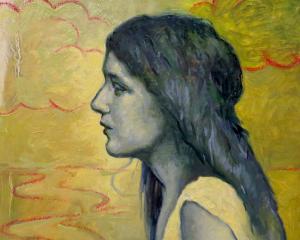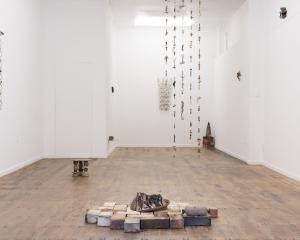
Perhaps his most memorable, and certainly his loudest, creation took place at Wellington’s Balaena Bay in November 1982.
Helped by the New Zealand Army Engineers, Nicholls used an explosive charge to fire a 3-tonne boulder on to a large rectangular plate of sheet steel, heated to a dull red. The steel plate crumpled around the propelled boulder, creating an audible boom as well as a new artwork.
The aptly titled Full Stop was an artistic landmark for much of the decade, though by 1990 most of the steel sheet had, as expected, dissolved in the salty sea air.
Nicholls’ other public artworks were less boisterous in their construction and appearance, though the rough-hewn quality of many of his monumental works in wood remind viewers of the hours of thought and labour devoted to planning and creating them.
Nicholls died at home in Dunedin on February 3, aged 84.
His contribution to the art of Aotearoa New Zealand was considerable. While he absorbed and made use of many artistic influences — modernism, abstract expressionism, minimalism, Arte Povera, environmental art — he drew equal inspiration from the landscape and history of his homeland. The result was a unique artistic vision and a career spanning five decades.
Peter Clement Fife Nicholls was born in Whanganui on April 27, 1936.

In the following years, Nicholls worked as an art teacher at several schools, mostly in the Auckland area, while he continued to create and exhibit sculptures.
In January 1965, he met Di ffrench in Auckland; they married five months later. His wife would go on to have an important and successful career as a photographic and performance artist, and the couple often worked together. They had four children and, in 1970, they built a home in Glenfield, north of Auckland.
Nicholls tended to create sculptures in series. Works from "Probe — New Zealand Bush" (1970-72) were shown in Auckland and in Australia and brought him early attention. Nicholls noted that the Probe series was partly inspired by the experience of building his Glenfield home in an area of dense growth, though the sculptures also call to mind the farm fences of his youth.
His next series, "New Land" (1975-78), was a more overt commentary on colonialism’s impact on the land. In New Land XI (1975), a work in memory of his mother, Marjorie Nicholls (nee Taylor), Nicholls embedded the handle of an axe into a wooden sculpture. This joining of natural and human-made would become an important element in his later work.
A key year in Nicholls’ development as a sculptor was 1978. He and his family travelled to North America, where he won a sculptural commission for the Muttart Conservatory in Edmonton, Canada, and completed a one-year master’s degree at the University of Wisconsin-Superior.
The family returned to New Zealand in 1979, moving to Dunedin, where he took up a lectureship in sculpture at the Otago Polytechnic School of Art, a position he held until 2001.
He returned with a new collection of works, the "Wisconsin" series, showing the influence of North American artists, including Mark Di Suvaro, whom Nicholls met during his travels. One of the Wisconsin works is today in the Dunedin Hospital collection; another, built in Dunedin (and renamed Measure), sits in the courtyard of the University of Auckland School of Architecture and Planning.
As his commissions grew in the 1980s, Nicholls’ reputation flourished. Spine (1985–86) stood outside first the Auckland Art Gallery then the Auckland War Memorial Museum.

Care for the environment always featured strongly in Nicholls’ work, but in the 1990s, these concerns were inflected by family history. An ancestor on his mother’s side, the missionary Richard Taylor (1805-73), worked mostly along the Whanganui River, preaching the gospel and spreading European plant seeds throughout the region.
Nicholls’ 1992 touring exhibition, Crossings, featured smaller sculptures that reflected on this ambivalent inheritance.
A key work, titled Whanganui (1992, today in the Sarjeant Gallery), melded a mixture of native and introduced woods in a curving sculpture that, river-like, twisted along the gallery floor. Nicholls embedded into the wood various objects — an adze head, a compass — suggesting the human impact on the river.
Visitors to the Gibbs Farm sculpture park, north of Auckland, can see Nicholls’ impressive Rakaia (1996-97) beside works from some of the most famous sculptors of the past century. The work’s twisting branches evoke a braided river, though its red colour also brings to mind a circulatory system.
Following his first wife’s death in 1999, Nicholls was closely involved in the retrospective of her work that was held at the Robert McDougall Art Gallery in Christchurch in 2000. He championed her work for the rest of his life.
In June 2001, Nicholls married Stephanie Bate. The two lived beside the Otago Harbour in Maia for all of their married life.
Nicholls, now recognised as one of New Zealand’s leading sculptors, completed major works in South Korea (Rhapsody, 2005), on Waiheke Island (Tomo, 2005), and for Manukau City (Frangipani, 2006).
The Dunedin Public Art Gallery, which had curated a mid-career retrospective in 1984, presented a second retrospective, "Journeywork: The Sculpture of Peter Nicholls", in 2008. His largest creation, Junction, an 8m-tall commission for New Lynn, appeared in 2009.
Nicholls completed a few more large works. The beautiful and contemplative As It Is On Earth (2010), made wholly of swamp kauri, was shown at Dunedin’s Temple Gallery in 2010 and at the Eastern Southland Gallery in Gore in 2013. The appropriately named Grit was included in a 2015 exhibition at Dunedin’s First Church commemorating the centenary of World War 1.
But many of his later works were on a smaller scale. The "Synthesis" series brought together swamp kauri and gorse in a succession of strikingly beautiful works that, in their combination of native and introduced woods, also commented on New Zealand’s own struggle to find a national identity.
As a member and sometime-chairman of the Otago Art Society, Nicholls remained an active force in the Dunedin art scene. In 2009, he worked with poet Peter Olds to commemorate the Municipal Tepid Baths in lower Moray Pl, and to preserve the marks carved into the Oamaru stone by children waiting to enter the baths from 1914 to 1964.
In his later years, osteoarthritis made it difficult to work on sculptures, so Nicholls returned to drawing, creating delicate, impressionistic images of the Otago landscape in the changing light.
In September 2019, Nicholls’ final exhibition opened at the Fe29 gallery in St Clair. It brought together vibrant works and beautiful maquettes from across his career.
One of the most admired works in the exhibition, Old Blue (2013), commemorated the conservationist Don Merton. As James Dignan wrote in the ODT: "It is hard not to see something of a self-portrait of Nicholls in Old Blue, with its striding protective figure and avian companions.”
In October 2019, Nicholls suffered a first stroke, but with persistent effort, and the loving support of his wife and friends, he recovered remarkably well. His wife recounts that, shortly after the stroke, a doctor showed Nicholls a pen, asking him to identify what it was. Instead, Nicholls took the pen, grabbed a nearby newspaper, and started drawing on it.
He walked slowly, usually with a cane, but his love of life and art never diminished. In January 2021, he suffered a second stroke. After several days in the hospital, Nicholls was allowed to return home, enabling family and friends to say final goodbyes.
On February 9, friends and admirers joined together at a requiem Mass in his memory at All Saints’ Church in Dunedin.
Peter Nicholls is survived by wife Stephanie, children Copelia, Kirk, Patrick and Ashley, and stepchildren Stephen and Emma.
— Tom McLean












